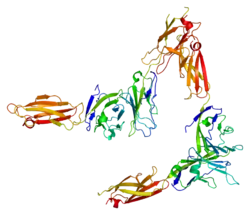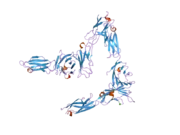SLAMF6
SLAM family member 6 is a protein that in humans is encoded by the SLAMF6 gene.[5][6]
The protein encoded by this gene is a type I transmembrane protein, belonging to the CD2 subfamily of the immunoglobulin superfamily. This encoded protein is expressed on Natural killer (NK), T, and B lymphocytes. It undergoes tyrosine phosphorylation and associates with the Src homology 2 domain-containing protein (SH2D1A) as well as with SH2 domain-containing phosphatases (SHPs). It may function as a coreceptor in the process of NK cell activation. It can also mediate inhibitory signals in NK cells from X-linked lymphoproliferative patients.[6]
References
- GRCh38: Ensembl release 89: ENSG00000162739 - Ensembl, May 2017
- GRCm38: Ensembl release 89: ENSMUSG00000015314 - Ensembl, May 2017
- "Human PubMed Reference:". National Center for Biotechnology Information, U.S. National Library of Medicine.
- "Mouse PubMed Reference:". National Center for Biotechnology Information, U.S. National Library of Medicine.
- Bottino C, Falco M, Parolini S, Marcenaro E, Augugliaro R, Sivori S, Landi E, Biassoni R, Notarangelo LD, Moretta L, Moretta A (Aug 2001). "NTB-A [correction of GNTB-A], a novel SH2D1A-associated surface molecule contributing to the inability of natural killer cells to kill Epstein-Barr virus-infected B cells in X-linked lymphoproliferative disease". J Exp Med. 194 (3): 235–46. doi:10.1084/jem.194.3.235. PMC 2193462. PMID 11489943.
- "Entrez Gene: SLAMF6 SLAM family member 6".
Further reading
- Claus M, Meinke S, Bhat R, Watzl C (2007). "Regulation of NK cell activity by 2B4, NTB-A and CRACC". Front. Biosci. 13 (13): 956–65. doi:10.2741/2735. PMID 17981603.
- Hercend T, Meuer S, Brennan A, et al. (1984). "Natural killer-like function of activated T lymphocytes: differential blocking effects of monoclonal antibodies specific for a 90-kDa clonotypic structure". Cell. Immunol. 86 (2): 381–92. doi:10.1016/0008-8749(84)90393-9. PMID 6610481.
- Kong G, Dalton M, Wardenburg JB, et al. (1996). "Distinct tyrosine phosphorylation sites in ZAP-70 mediate activation and negative regulation of antigen receptor function". Mol. Cell. Biol. 16 (9): 5026–35. doi:10.1128/MCB.16.9.5026. PMC 231504. PMID 8756661.
- Lee YJ, Luisiri P, Clark MR (1996). "A novel complex, p40/42, is constitutively associated with the B cell antigen receptor and phosphorylated upon receptor stimulation". J. Immunol. 157 (9): 3828–37. PMID 8892612.
- Gray CW, Ward RV, Karran E, et al. (2000). "Characterization of human HtrA2, a novel serine protease involved in the mammalian cellular stress response". Eur. J. Biochem. 267 (18): 5699–710. doi:10.1046/j.1432-1327.2000.01589.x. PMID 10971580.
- Strausberg RL, Feingold EA, Grouse LH, et al. (2003). "Generation and initial analysis of more than 15,000 full-length human and mouse cDNA sequences". Proc. Natl. Acad. Sci. U.S.A. 99 (26): 16899–903. doi:10.1073/pnas.242603899. PMC 139241. PMID 12477932.
- Del Valle JM, Engel P, Martín M (2003). "The cell surface expression of SAP-binding receptor CD229 is regulated via its interaction with clathrin-associated adaptor complex 2 (AP-2)". J. Biol. Chem. 278 (19): 17430–7. doi:10.1074/jbc.M301569200. PMID 12621057.
- Tangye SG, Nichols KE, Hare NJ, van de Weerdt BC (2003). "Functional requirements for interactions between CD84 and Src homology 2 domain-containing proteins and their contribution to human T cell activation". J. Immunol. 171 (5): 2485–95. doi:10.4049/jimmunol.171.5.2485. PMID 12928397.
- Clark HF, Gurney AL, Abaya E, et al. (2003). "The secreted protein discovery initiative (SPDI), a large-scale effort to identify novel human secreted and transmembrane proteins: a bioinformatics assessment". Genome Res. 13 (10): 2265–70. doi:10.1101/gr.1293003. PMC 403697. PMID 12975309.
- Valdez PA, Wang H, Seshasayee D, et al. (2004). "NTB-A, a new activating receptor in T cells that regulates autoimmune disease". J. Biol. Chem. 279 (18): 18662–9. doi:10.1074/jbc.M312313200. PMID 14988414.
- Flaig RM, Stark S, Watzl C (2004). "Cutting edge: NTB-A activates NK cells via homophilic interaction". J. Immunol. 172 (11): 6524–7. doi:10.4049/jimmunol.172.11.6524. PMID 15153464.
- Zhang Z, Henzel WJ (2005). "Signal peptide prediction based on analysis of experimentally verified cleavage sites". Protein Sci. 13 (10): 2819–24. doi:10.1110/ps.04682504. PMC 2286551. PMID 15340161.
- Gerhard DS, Wagner L, Feingold EA, et al. (2004). "The status, quality, and expansion of the NIH full-length cDNA project: the Mammalian Gene Collection (MGC)". Genome Res. 14 (10B): 2121–7. doi:10.1101/gr.2596504. PMC 528928. PMID 15489334.
- Stark S, Watzl C (2006). "2B4 (CD244), NTB-A and CRACC (CS1) stimulate cytotoxicity but no proliferation in human NK cells". Int. Immunol. 18 (2): 241–7. doi:10.1093/intimm/dxh358. PMID 16410313.
- Gregory SG, Barlow KF, McLay KE, et al. (2006). "The DNA sequence and biological annotation of human chromosome 1". Nature. 441 (7091): 315–21. Bibcode:2006Natur.441..315G. doi:10.1038/nature04727. PMID 16710414.
- Eissmann P, Watzl C (2006). "Molecular analysis of NTB-A signaling: a role for EAT-2 in NTB-A-mediated activation of human NK cells". J. Immunol. 177 (5): 3170–7. doi:10.4049/jimmunol.177.5.3170. PMID 16920955.
- Cao E, Ramagopal UA, Fedorov A, et al. (2006). "NTB-A receptor crystal structure: insights into homophilic interactions in the signaling lymphocytic activation molecule receptor family". Immunity. 25 (4): 559–70. doi:10.1016/j.immuni.2006.06.020. PMID 17045824.
- Banerjee P, Feuer G, Barker E (2007). "Human T-cell leukemia virus type 1 (HTLV-1) p12I down-modulates ICAM-1 and -2 and reduces adherence of natural killer cells, thereby protecting HTLV-1-infected primary CD4+ T cells from autologous natural killer cell-mediated cytotoxicity despite the reduction of major histocompatibility complex class I molecules on infected cells". J. Virol. 81 (18): 9707–17. doi:10.1128/JVI.00887-07. PMC 2045425. PMID 17609265.
This article is issued from Wikipedia. The text is licensed under Creative Commons - Attribution - Sharealike. Additional terms may apply for the media files.





